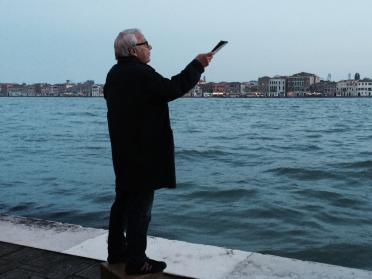The Laguna's Tribute : A Corner Speaker in Venice
Saâdane Afif

Born in 1970 in Vendôme (France), lives and works in Berlin (Germany).
Date:
2015
Medium:
Exhibition-Performance

The Laguna's Tribute : A Corner Speaker in Venice is a performance produced and presented in 2015, on the occasion of the 56th Venice Biennale. It connects two distinct spaces, thus taking up a device established by Saâdane Afif, inaugurated in 2011 during the exhibition "Meeting Point 6" at the Beirut Art Center and refined thereafter.
The first place is an art space (museum, art center, gallery) which hosts in one of its rooms an exhibition presenting a selection of texts of songs, the cartels that refer to the works cited by these texts, then one or more versions of the same poster announcing an event in a place. The exhibition marks different temporalities, it indicates that something is happening, that a transition is in progress.
The second place, in another part of the city, is the public space that hosts the performance. At the corner of a street, a character declaims or sings daily the texts presented in the exhibition, perched on a bronze crate installed throughout the Biennale. This base is recessed on the ground along the docks between the arsenal and the Giardini, around the corner of Garibaldi Street.
The speaker declaims the texts of songs facing the lagoon. It is aimed at fish and vaporetto, in a very romantic vision, like a painting by Caspar David Friedrich. He turns his back on the flow of passers-by avoiding any direct confrontation. The viewer can stop, listen, make fun of the performer. He can give free rein to his curiosity.
The texts constitute the material and the posters are the credits or the synthesis. The speaker is the interface, finally the public becomes the witness. The artwork, whose epicenter is located in a space dedicated to the exhibition, has an action on the reality of a a third place, the street. The performance, perceived as a spontaneous manifestation, distorts a piece of reality of the city where it takes place. The regularity and repetition of the arrival of a character at fixed times, in a given district, must transform the perception by its inhabitants and surprise those who cross it. The remoteness of performance and exhibition space is essential to avoid any analogy with theater or attraction.

The Laguna's Tribute : A Corner Speaker in Venice
© Lafayette Anticipations